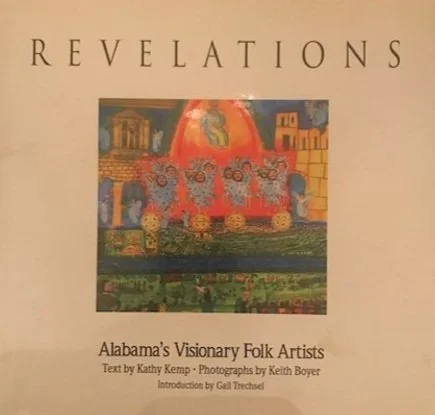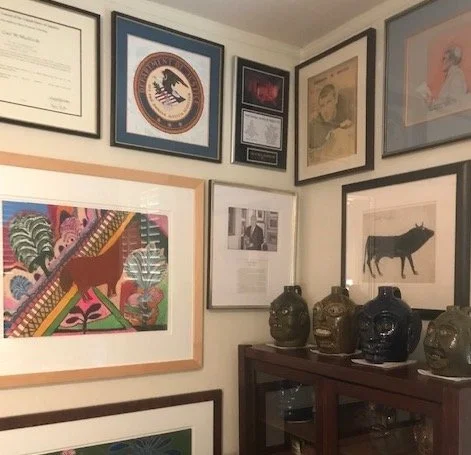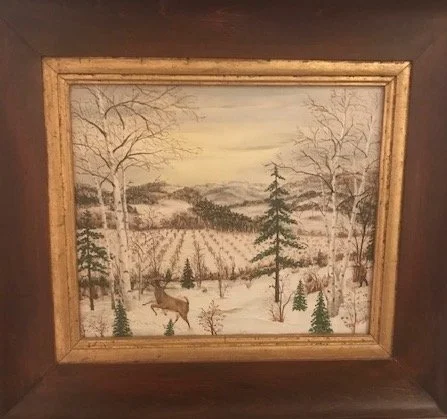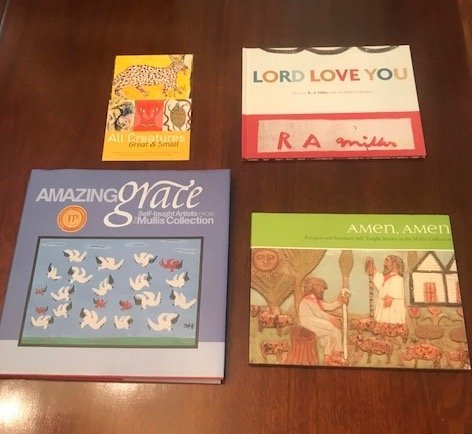CARL MULLIS, ATLANTA - MEET THE COLLECTOR SERIES PART SIXTY-SEVEN
For part sixty-seven of my Meet the Collector series, I interviewed Atlanta based Carl Mullis over zoom. Norm Brothers introduced me to Carl and, after seeing extensive photos of his very art filled home, we are talking floor to ceiling art, I was hooked to learn more. Read on to hear how Carl’s tastes have come full circle over the years, and the American focus of his self-taught and folk art collection.
Carl at the Westmoreland Museum of American Art for the ’Gatecrashers’, standing with a Patsy Santo artwork that he loaned to the exhibition
Jennifer: Let's start talking about you, your background and what you did for work.
Carl: I'm a retired attorney. I grew up in a small town in South Carolina. I attended Yale University and then went to Emory Law School in Atlanta. In 1975, I graduated from law school and became an attorney for the Antitrust Division of the U.S. Dept. of Justice. After 12 years, I entered private practice in Atlanta. In 2007, I retired, but my law firm persuaded me to come back and handle 2 cases in NYC. Two years later I retired for good. I've been very involved with art during my retirement, including being chairman of the Board of Advisers for the Georgia Museum of Art (GMOA) for a number of years.
Jennifer: What year would you say your interests in this field of folk art/outsider art began, and what would you say triggered you to become interested in it?
Carl: I attended Yale on a scholarship, and as part of my scholarship I worked 10-15 hours a week for the university. My Junior and Senior years, I worked at Yale's Art and Architecture Library. I also had a good friend who was an art major. This exposure to art resulted in my developing an interest in art. When I started working at D.O.J., I began to collect prints because I could afford them. Subsequently, I visited Abe Tahir's print gallery in New Orleans and became interested in American prints between the World Wars. In 1986, I guest curated an exhibit on American prints for the High Museum of Art. I also began to purchase American paintings, but I didn't have the financial resources to acquire masterworks by many of the painters that I wanted to collect.
In 1994, I attended Folk Fest (a show of self-taught art dealers) in Atlanta. While walking through the show, I was struck by a painting that was in Marsha Weber's booth. (Marsha is a dealer from Montgomery, Alabama.) The piece was by Myrtice West and titled "Ezekiel Visions #2." The painting had great wall power, was colorful, had lots of energy, was Southern, and was illustrated on the front cover of a new book by Kathy Kemp titled "Revelations: Alabama's Visionary Folk Artists." It also was affordable. This painting became the first piece of self-taught that I acquired, and I still have it today. The more I looked at and studied Southern self-taught art, the more I realized that I would like to try to build an iconic collection of this art. Not only did I love the art; but it was affordable; great works were accessible for someone living in Atlanta (a large amount of great Southern self-taught art was made within 200 miles of Atlanta); and a number of the artists were women and/or African Americans. So, I began my journey into collecting Southern self-taught art.
In 1998, the High Museum of Art hosted a traveling exhibition organized by the American Folk Art Museum titled "Self-Taught Artists of the 20th Century." It was a great exhibition, and it included a wonderful 1885 stone sculpture by Henry Church titled "A Friend In Need Is A Friend Indeed." It's a sculpture of a shepherd protecting a lamb from a mountain lion while the shepherd's dog is on top of the mountain lion trying to protect the shepherd. This was my wife's and my favorite piece in the exhibition. It truly spoke to us. In 2010, I was able to purchase this sculpture from the artist's family, and we put it on extended loan with the High.
After we acquired "A Friend In Need Is A Friend Indeed," my collecting journey added a new path. I began to study American self-taught art from the early 20th Century. As I learned more about these artists, I began to acquire their work. I was particularly influenced by MOMA's 1938 "Masters of Popular Painting: Modern Primitives of Europe and America" exhibition and its catalogue, and by Sidney Janis' "They Taught Themselves: American Painters of the 20th Century" exhibition and catalogue. More recently I have started learning about Wilhelm Uhde's Painters of the Sacred Heart (Henri Rousseau, Seraphine Louis, Andre Bauchant, Louis Vivin and Camille Bombois) who were included in MOMA's "Masters of Popular Painting" exhibition, and I have begun to acquire a few works by these European self-taught artists.
Around 2010, I also became interested in Southern alkaline pottery. I started collecting Edgefield pottery, which was made by enslaved African Americans in Edgefield, S.C. in the 1840's to 1860's. (One of our pots is in the MET's "Hear Me Now: The Black Potters of Old Edgefield, South Carolina" exhibition and catalogue.) We also have collected the Southern potters (e.g., the Meaders family) who have continued this pottery tradition.
Above: Myrtice West’s Ezekiel Visions #2, and the book cover it features on
Jennifer: Where did you acquire most of the self-taught art in your collection? Was it dealers, auctions or the artists directly?
Carl: We primarily purchased this art from dealers and auctions. Because the dealers and auctions vetted the art that they sold, it was easier to buy great examples of this art from them. There were three self-taught artists (R.A. Miller, Toby Ivey and Willie Jinks) in the Atlanta area whose art we purchased from dealers and from the artists directly. We acquired wonderful pieces and multiple examples from these artists.
Jennifer: Is there a reason why your focus is on American artists, as you've only just started moving into Europe? Why do you keep it so focused?
Carl: The reason we have kept it so focused is because we have a limited number of resources - both in time and in finances. It was our goal to try to build an iconic collection of self-taught art. (We're still working on that, but it has been a lot of fun.) Knowledge and having a good eye are important parts of being a good collector. They are needed to be able to know what to buy, where to search for a piece, when to buy it, what to pay and what else is needed for the collection. Acquiring knowledge and developing a good eye take time. Focusing on a particular area of art can provide you with the time to try to become an expert in that area. Acquiring great pieces of art can also be expensive. Focusing a collection may help limit the finances that are required for building a strong collection. I've come to learn that I just can't collect it all even though I might love it all.
Jennifer: Other than your prints, would you say that painting is the main thing that you collect, and then pottery too, or is there anything else?
Carl: Paintings, works on paper and pottery are primarily what I collect. I do have several stone sculptures by Tim Lewis, a Kentucky self-taught artist, that are fabulous.
Henry Church, “A Friend In Need Is A Friend Indeed,” on view at the High Museum
Jennifer: Do you have any concept on how many pieces you now have in your collection? And where do you keep it all?
Carl: I'm an old print collector, so we have a number of pieces - certainly over a hundred. Much of the work is on the walls of our home, but there are pieces in a print cabinet, under our bed, behind the couch and in our garage. There also are several pieces on loan to museums.
Jennifer: So, with all the extra work that you have, do you often do re-hangs in your house and do you move things around?
Carl: We have a small 1920's arts and crafts house that I've lived in for 45 years. It has several mortar walls which make it difficult to move things around without having to repair the walls. When we first started collecting self-taught art, we did more rehanging. In those early years we were influenced by comments from curators who visited with us to see our collection. We would tell the curators that the price of admission for seeing the collection was that we would like for them to tell us their three favorite pieces in the collection and their three least favorite pieces. It was easy for the curators to tell us their favorite pieces, but more difficult for them to tell us their least favorite pieces, because they were concerned about hurting our feelings. We learned a great deal from these comments from visiting curators - especially their comments concerning their least favorite pieces.
Jennifer: So, I guess you are asking a lot of people about their favorites, but do you have a favorite artist or a favorite piece of work in your collection?
Carl: I thought you were going to ask that question! A lot of collectors, including myself, respond to that question by saying that the art they own is like their children and that they love all of their children.
Jennifer: That's a good response. But if your house was burning down, and you get to grab one picture, what would that be?
Carl: That's a good follow-up question. You love all of your children equally, but from week to week different children may be your favorite, because of their good or bad behavior or something special they have done. Just like your children, I love all of our pieces of art, but from week to week I may have different favorites that I focus on, and think about, and look at; and if truth be told, that I love the most. So, this week my favorites are my prodigal children. My favorite prodigal which has left home is Henry Church's "A Friend In Need Is A Friend Indeed." (I'm biased, but I believe this piece is one of the masterpieces of 19th Century American folk art.) This piece will never come home because it is now owned by the High, but I visit it every couple of weeks.
There are other prodigals that are my favorites this week. One of these is a piece by Josephine Joy titled "Symbol of Love" that is on loan to the High. Joy was the first female painter to have a solo exhibition at MOMA. Other favorite prodigals include: Lawrence Lebuska's "Horses and Rattlesnake" on loan to the High's "Gatecrashers" exhibition; Howard Finster's "George Washington" on loan to Crystal Bridges Museum of American Art; and Collin Rhodes 1847 pot on loan to the MET's "Hear Me Now" exhibition.
Jennifer: But none of these are currently in your house. Do you have any favorites at home now?
Carl: This week one of my favorite pieces that is in my house is a marvellous painting on canvas by Toby Ivey. It is a bright, colorful imaginary landscape with reindeer, birds, dogs, trees and a large pink sun. (I hung it on the wall several days ago to cover an empty space that was created when we shipped a piece by Leroy Almon to Crystal Bridges for an upcoming exhibition.) Toby was an African American who lived about three miles from our house, and I visited him often for a year and a half before he passed. He was a remarkable colorist. He had a solo show at Barbara Archer's Gallery in Atlanta. Most of Toby's works are on paper, and a piece on canvas is rare.
Another favorite hanging in our house is a painting by Patsy Santo titled "The End of the Trail." It was once owned by Walt Kuhn and was included in MOMA's 1943 "American Realists and Magic Realists" exhibition. More recently it has been illustrated in the Brandywine Museum of Art's "Rural Modern: American Art Beyond the City" catalogue and in GMOA's "Extra Ordinary: Magic, Mystery, and Imagination in American Realism" catalogue. It's a poignant painting of a hunter shooting a deer. Quite striking.
Photo of artwork installed in Carl’s home
Jennifer: And if you were going to say whether there was an exhibition that you've been to that you think was important within this field, what would you say that was? A lot of collectors say the Corcoran's 1982 "Black Folk Art" exhibition, would you agree?
Carl: Yes, I would agree. The Corcoran exhibition was an incredibly important exhibition, and I was lucky enough to attend the exhibition. Because the exhibition focused on African American self-taught artists of the South, it was very influential in our early decisions as to which artists to collect. (We have been lucky enough to acquire a piece which is illustrated in the exhibition's catalogue.)
There have been a number of important exhibitions in the area of American self-taught art. We've already mentioned several of them. Some additional ones that have great catalogues include: Ramona Lampell's "O,Appalachia: Artists of the Southern Mountains"; Alice Rae Yellen's "Passionate Visions of the American South: Self-Taught Artists from 1940 to the Present"; Bill Arnett's "Souls Grown Deep: African American Vernacular Art of the South"; Carol Crown's "Coming Home!: Self-Taught Artists, the Bible and the American South"; Lynne Cooke's "Outliers and American Vanguard Art"; and Katherine Jentleson "Gatecrashers: The Rise of the Self-Taught Artist In America."
There have been a number of important solo exhibitions with catalogues on American self-taught artists. A few that come to mind are Susan Crawley's exhibitions on Ulysses Davis, Jimmy Lee Sudduth and William Hawkins; William Fagaly's exhibition on Sister Gertrude Morgan; Leslie Umberger's exhibition on Bill Trayler; Nancy Ireson and Zoe Whitley's exhibition on Elijah Pierce; Mark Pascale, Esther Adler, and Edouard Kopp's exhibition on Joseph Yoakum; Katherine Jentleson's exhibition on Nellie Mae Rowe; Maxwell King and Louise Lippincott's exhibition on John Kane; and Richard Meyer's exhibition on Morris Hirshfield.
The catalogues for all these great exhibitions are incredibly important. If you want to be a serious collector of American self-taught art, then you need to learn as much as you can about the artists and the art they produced. These catalogues are an essential part of that process. Acquiring knowledge is an important step toward becoming a great collector. Reading and studying these catalogues helps you acquire some of the knowledge, insight and wisdom of all these great curators.
Patsy Santo, ‘The End of the Trail’
Jennifer: Great. And then if we, if we move on to people, is there anyone that you think was really important to this field?
Carl: There are a number of people who have made important contributions to this field. All of the people whom you have interviewed for this series have made important contributions and all of the curators whom I have named have made important contributions. There are numerous additional great curators, museum directors, scholars, dealers and collectors (many of whom are friends of mine) who have made significant contributions to this field, but whom I don't have enough time to mention. (I hope they will forgive me.) Elizabeth Stillinger has written an interesting book titled "A Kind of Archeology: Collecting American Folk Art, 1876-1976" in which a number of early important contributors to this field are discussed.
There is one fairly recent act by a dealer/collector that should be mentioned because it has had an important effect on the field of Southern self-taught art. This is Bill Arnett's gift of several important pieces of African American vernacular art to the Souls Grown Deep Foundation. The Foundation has disseminated a large amount of this art through gift/purchases to many museums.
Jennifer: I know you said that in the last few years you've only bought about ten works, but is there anyone that you would still like to add to your collection?
Carl: There's always artists missing that you would like to add to your collection. There are several important artists that have passed me by because they have become so expensive. These include artists like Edward Hicks and Horace Pippin. I doubt that I will own a large Edmondson sculpture or a Morris Hirshfield. Nor will I own a Henri Rousseau or a Van Gogh.
Jennifer: Well yes, I think that is way, way out of most people's budgets. When you've had exhibitions from your collection, like there was one in the airport near you, did people approach you to do those exhibitions, or did you approach people and suggest a show based on your collection?
Carl: There have been four exhibitions based on our collection. Three of the exhibitions were done by the Georgia Museum of Art, and they approached me about the exhibitions. The first exhibition and catalogue was in 2007 and titled "Amazing Grace: Self-Taught Artists from the Mullis Collection." It included 90 pieces from our collection. The next exhibition and catalogue was in 2009 and titled "Lord Love You: Works by R.A. Miller from the Mullis Collection." The third exhibition from our collection was titled "All Creatures Great and Small," and it was exhibited at the Atlanta airport for two years. This exhibition consisted of work by self-taught artists that included images of animals. The fourth exhibition was done by the Jundt Art Museum, Gonzaga University in 2014. It was titled, "Amen, Amen: Religion and Southern Self-Taught Artists in the Mullis Collection."
Jennifer: When you eventually move on to your next life, have you already decided that you will leave your collection to the High Museum and/or to Georgia, or will it be separated out?
Carl: We've donated numerous prints and works of self-taught art to the High and GMOA. Both museums also have several works from us that are promised gifts. We've also made donations to other museums. I'm sure we will make additional donations to the High and GMOA. We haven't determined what will happen to the remaining bulk of our collection, although we have some ideas. It is still a work in progress.
Books from exhibitions showcasing art from the Mullis Collection
Jennifer: In terms of how you describe your collection, do you say that they're self-taught and/or folk artists, and do you ever use the term outsider art?
Carl: I don't use the term outsider art. I describe most of our collection as self-taught art and our pottery and baskets as folk art.
Jennifer: Where you're based in America, do you think the term outsider art is used frequently or do you think it's more self-taught and folk art?
Carl: I believe the terms self-taught and folk art are used more frequently in the South.
Jennifer: So that's all of my questions. Is there anything else that you'd like to add?
Carl: Yes. I love self-taught art. Collecting it has brought great pleasure to my life. It is clear to me that I am very blessed. My life is interesting and a lot of fun. I live a good life. Over the years, I have learned three secrets to being able to live the good life. The first secret is to make sure the world is a better place than it would have been had you not lived here. Making the world a better place will provide meaning and purpose to your life. The second secret is that you need to have a passion in your life. You need something that you are passionate about. It can be collecting art, playing golf or tennis, writing, going to baseball games - it doesn't matter as long as you are passionate about it. This will make your life interesting. The third secret is to learn to enjoy the simple things in life. You don't need to have the most expensive house or drive the fanciest car or have the largest art collection - you just need to learn to enjoy the simple things: the beauty of a flower or the smell of coffee in the morning or the pleasure of petting your dog. There are so many wonderful things in this world, and you just need to appreciate them. Doing this will bring pleasure and joy to your life. But for me perhaps the greatest secret to my living a good life is that I have a loving and kind wife whom I adore.
Jennifer: Sounds good to me. Thanks so much.
R.A Miller that has been donated to the High Museum







